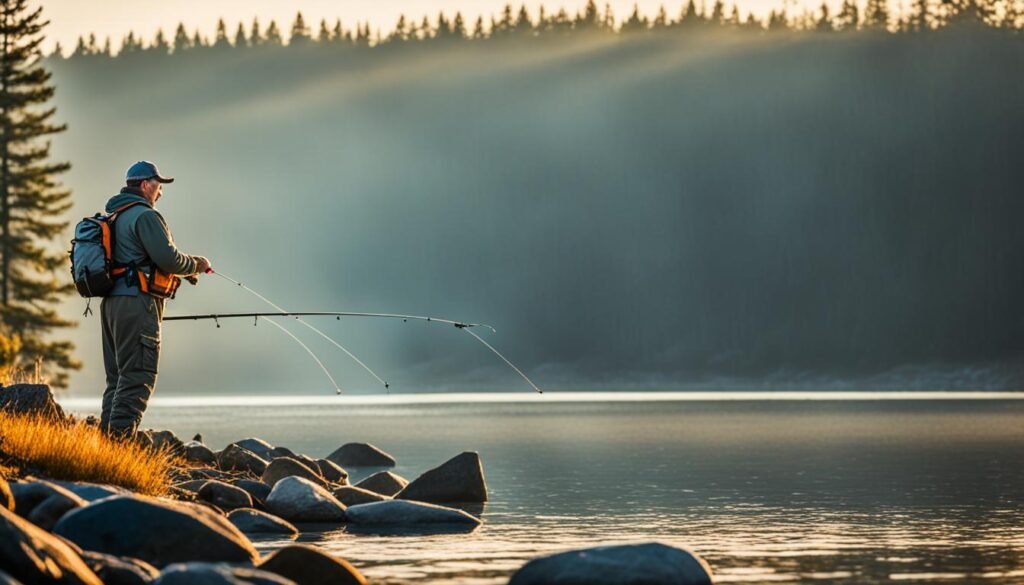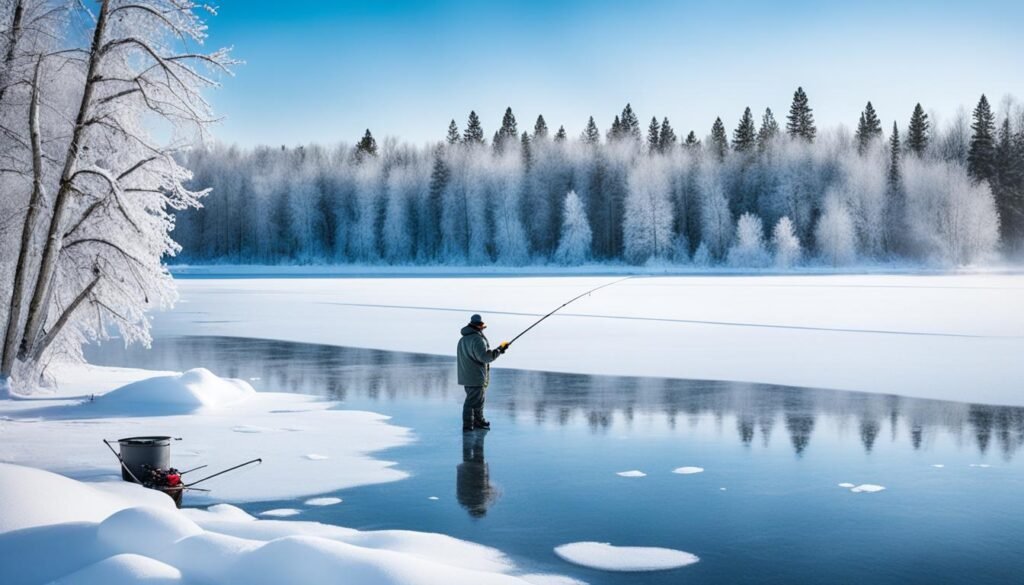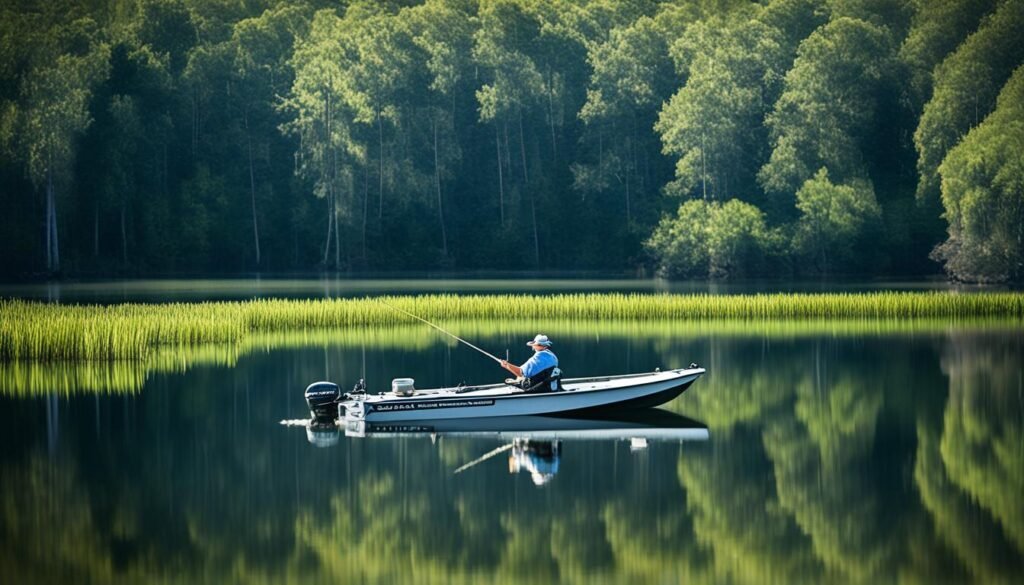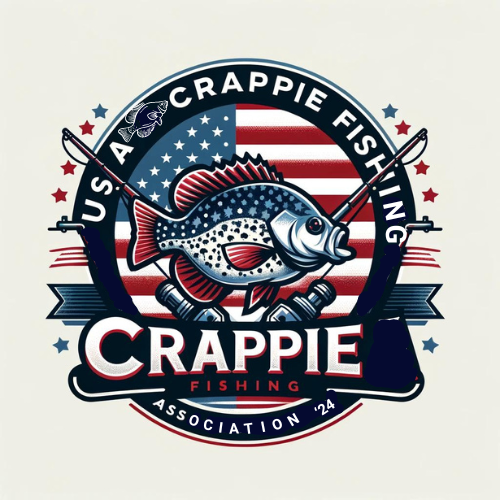“Fishing is much more than fish. It is the great occasion when we may return to the fine simplicity of our forefathers.” – Herbert Hoover
If you’re an angler looking for a thrilling fishing experience and a delicious meal, then crappie fishing is for you! Crappie, also known as speckled perch or papermouths, are highly sought-after freshwater panfish known for their aggressive strikes and delicate flavor. To enhance your chances of a successful crappie fishing expedition, it’s essential to understand their behavior, preferred habitats, and effective fishing techniques.
In this article, we will dive into the world of crappie fishing and share expert tips, strategies, and methods to help you reel in these prized panfish. Whether you’re a beginner or an experienced angler, these crappie fishing techniques will set you on the path to success.
Key Takeaways:
- Understanding crappie behavior and habitat is crucial for successful fishing.
- Crappie can be found in various bodies of water throughout the US.
- Choosing the right tackle, including rods, reels, and lines, is essential.
- Effective crappie fishing techniques include vertical jigging, trolling, casting, spider rigging, and shooting docks.
- Baits such as jigs, minnows, and artificial lures can attract crappie.
Where to Find Crappie
Crappie, a popular fish among anglers, can be found in various locations depending on water conditions and their behavior. Understanding their habitat, preferred cover, and spawning patterns can greatly enhance your chances of locating and catching them.
Crappie Habitat and Behavior
Crappie are known to inhabit a range of freshwater environments, including lakes, reservoirs, rivers, and ponds. They are particularly prevalent in the United States and are prized for their sporting qualities and delicious taste.
Crappie behavior and location can vary depending on the time of year and water temperature. During the spawning season, which typically occurs when the water temperature reaches the high 50s, crappie move from their deep winter haunts to shallower areas with suitable cover.
It is crucial to identify their preferred spawning locations to increase your chances of success. Crappie may be found near grass edges, stumps, fallen trees, and other types of cover where they can lay their eggs and protect their young.
Outside of the spawning season, crappie can be found in mid-depth cover and deeper water. They may also suspend over deep water during certain times of the year, particularly in hot weather or very cold conditions.
Finding Crappie: Preferred Cover and Spawning Locations
Finding crappie requires careful observation and knowledge of their preferred cover and habitat. By identifying potential spawning areas and favored cover, you can target your fishing efforts more effectively.
“Crappie tend to populate areas with suitable cover, such as submerged vegetation, fallen trees, and brush piles. Focus on these areas to increase your chances of finding and catching crappie.”
When searching for crappie, keep in mind that they often seek shade and shelter. They may be found near docks, piers, overhanging vegetation, and other structures where they can find cover and ambush prey.
Additionally, pay attention to water clarity and temperature. Crappie often prefer clear water with good visibility, but they can also tolerate slightly stained or murky conditions. Understanding these variables can help you narrow down your search and increase your success rate.
Visual Aid: Crappie Preferred Cover and Spawning Locations
To provide you with a visual representation of crappie preferred cover and spawning locations, here is an illustration:
| Preferred Cover and Spawning Locations | Examples |
|---|---|
| Grass edges | Emergent vegetation, underwater grasses |
| Stumps | Submerged, partially submerged, or protruding stumps |
| Fallen trees | Sunken logs, submerged branches |
| Sunken brush piles | Artificial structures, sunken Christmas trees, PVC habitats |
| Overhanging vegetation | Docks, piers, trees, shrubs |
Understanding the preferred cover and spawning locations of crappie can significantly improve your chances of catching them. By targeting these areas and utilizing appropriate techniques and baits, you can have a more productive and enjoyable fishing experience.
Crappie Fishing Tackle You Need
To catch crappie successfully, it’s essential to have the right fishing tackle. Here are the must-have items:
Fishing Rod for Crappie
A limber rod designed specifically for crappie fishing is highly recommended. You have two options to choose from:
- Casting Rod: These rods are perfect for casting jigs or other artificial baits. They offer good sensitivity and allow for accurate casts.
- Vertical Fishing Rod: Vertical rods are designed for techniques like vertical jigging. They have a sensitive tip that helps detect subtle bites.
Fishing Reel for Crappie
When it comes to reels, opt for a 1000 or 2000 size reel. These sizes provide a good balance between line capacity and weight. Look for a reel with a smooth drag system for better control during the fight.
Fishing Line for Crappie
Use a light fishing line for crappie, preferably 4-pound monofilament. Lighter lines allow for better lure action and increase your chances of getting more bites.
Crappie Bait Options
There are various bait options that work well for crappie. Consider the following:
- Jigs: 1/16-ounce jigs are considered a standard size for crappie. They come in a wide range of colors and designs to match the conditions.
- Live Minnows: Fishing with live minnows is another popular option. Rigging them on a hook with a small split shot weight can entice crappie to bite.
Remember, the choice of bait may vary depending on several factors such as water clarity, time of year, and personal preference.
Best Crappie Techniques
When it comes to catching crappie, there are several proven techniques that anglers can employ. Each technique has its advantages and may be more effective depending on personal preference and environmental conditions.
1. Vertical Jigging for Crappie
Vertical jigging is a popular technique for targeting crappie. It involves dropping a jig vertically into the water column and using a subtle up-and-down movement to entice crappie to strike. This technique is especially effective when crappie are holding in deeper water or around vertical structure.
2. Trolling for Crappie
Trolling is another effective method for catching crappie. It involves slowly moving a boat while dragging baits or lures behind. This allows anglers to cover a larger area of water and locate schools of crappie. Trolling can be done with a single rod or multiple rods spread out at different depths.
3. Casting for Crappie
Casting is a versatile technique that can be used in various fishing scenarios. It involves accurately casting a bait or lure to specific targets, such as underwater structure or the edges of weed beds. Casting allows anglers to explore different areas and present their bait in a natural and enticing manner to crappie.
4. Spider Rigging for Crappie
Spider rigging, also known as multiple pole fishing, is a technique commonly used by crappie anglers. It involves deploying multiple fishing rods, each equipped with a different bait or lure, and spreading them out in a fan-like pattern. This technique allows anglers to cover a wide area and increase their chances of encountering crappie.
5. Shooting Docks for Crappie
Shooting docks is a specialized technique that targets crappie hiding near overhanging tree limbs or docks. Anglers use a sidearm casting motion to skip a bait or lure under these structures to entice crappie to bite. This technique requires accurate casting skills and is particularly effective in lakes and rivers with docks and vegetation.
By utilizing these various crappie fishing techniques, anglers can increase their chances of success on the water. It’s important to experiment with different methods and adapt to the conditions to maximize your catches.

Comparison of Crappie Fishing Techniques
| Technique | Advantages |
|---|---|
| Vertical Jigging |
|
| Trolling |
|
| Casting |
|
| Spider Rigging |
|
| Shooting Docks |
|
Best Crappie Baits
When it comes to catching crappie, choosing the right bait can make all the difference. There are several effective options that anglers can use to attract these panfish. Some of the best crappie baits include:
- Live Minnows: Live minnows are a popular and effective bait for crappie. These small, lively fish can be hooked through the lips or behind the dorsal fin and presented to crappie.
- Jigs: Jigs are versatile and can emulate the movement of small baitfish, enticing crappie to strike. A 1/16-ounce jig with a soft plastic body is an excellent choice for targeting crappie.
- Crankbaits: Crankbaits can imitate injured or fleeing baitfish, attracting crappie when they are actively feeding in open water. These artificial lures can be particularly effective when crappie are chasing shad.
- Artificial Lures: Various artificial lures, including soft plastics, spinnerbaits, and spoons, can also attract crappie. Experimenting with different styles and colors can help determine which lures work best in specific fishing conditions.
Ultimately, the choice of bait depends on personal preference and the specific fishing conditions. Some anglers may prefer live minnows or jigs, while others may opt for the versatility and convenience of artificial lures. Whichever bait you choose, it’s important to consider the behavior of crappie and their preferred forage when making your selection.
“Using the right bait is crucial when targeting crappie. Live minnows, jigs, crankbaits, and artificial lures are all effective options that can help you land these prized panfish.”
Where to Look for Crappie
When searching for crappie, it’s essential to understand their preferred habitats and seasonal habits. By targeting the right areas, you can greatly increase your chances of success. Crappie tend to congregate near specific structures and locations, making them easier to locate.
Crappie Habitat and Structures
Crappie can often be found near underwater brush, sunken trees, and other structures. These structures provide cover and attract baitfish, which in turn attracts crappie. When scouting for crappie, focus on areas with submerged vegetation, cypress trees, stickups, and weed beds along the shoreline.
Shoreline Fishing for Crappie
One productive method of targeting crappie is shoreline fishing. Crappie frequently move closer to the shoreline during the spawning period, creating excellent opportunities for anglers. Look for shallow areas with suitable cover, such as fallen trees and overhanging branches. These are prime spots where crappie will gather during the spawning season.
Seasonal Habits and Locations
Understanding the seasonal habits of crappie is crucial for successful fishing. During certain seasons, crappie may move to deeper water, such as channel edges or main lake humps. By adjusting your fishing strategy according to the season, you can effectively target crappie in their preferred locations.
To summarize:
- Search for crappie near underwater brush, sunken trees, and other structures.
- Target shoreline structures such as cypress trees, stickups, and weed beds.
- Focus on shallow areas with cover for shoreline fishing during the spawning season.
- Adapt your fishing strategy based on the seasonal habits of crappie.
Mastering the art of locating crappie is an essential skill for any angler. By identifying crappie fishing spots, understanding their habitat and preferred structures, and adapting to their seasonal habits, you can greatly enhance your chances of a successful fishing trip.
Keep reading to discover the best techniques for catching crappie from the shoreline.
Techniques for Catching Crappie from Shoreline
When it comes to catching crappie, you don’t always need a boat to reel in these popular panfish. Many effective crappie fishing techniques can be applied right from the shoreline, allowing bank fishermen to have a successful and rewarding angling experience. Whether you prefer shore fishing for crappie, bank fishing for crappie, or fishing from a boat for crappie, there are strategic locations and techniques that can help you hook these prized fish.
One of the tried-and-true methods for catching crappie from the shoreline is using bobber and minnow rigs. This simple yet effective set-up involves attaching a small bobber to your line, followed by a hook with a lively minnow as bait. Cast your rig near shoreline structures, such as bridges or submerged trees, and let the bobber float on the surface. The subtle movements of the minnow will attract crappie, and when the bobber starts to dance or disappear beneath the water, you’ll know it’s time to set the hook.
Jig fishing is another popular technique for targeting crappie from the bank. Using a jig with a soft plastic body, cast your line near shoreline structures or areas with submerged cover. Allow the jig to sink to the desired depth before employing a slow and steady retrieve. This method mimics the natural movement of small prey fish and can entice crappie to strike. Experiment with different colors and sizes of jigs to determine what works best in your fishing location.
Casting jigs is also an effective approach when targeting crappie from the shoreline. Choose a lightweight jig (1/16-ounce is a good starting point) and cast it near shoreline structures or areas with underwater vegetation. Retrieve the jig with a slow and steady retrieve, occasionally pausing to imitate the movements of an injured baitfish. This technique can be especially productive when crappie are actively feeding near the shore.
To help you choose the best technique for your shoreline crappie fishing, here’s a handy table summarizing the key considerations for each approach:
| Technique | Description | Best Time to Use |
|---|---|---|
| Bobber and Minnow Rigs | Using a bobber and lively minnow as bait to attract crappie. | Any time of day, especially during periods of high activity. |
| Jig Fishing | Using a jig with a soft plastic body and a slow retrieve to mimic prey fish. | Early morning and late afternoon when crappie are more active. |
| Casting Jigs | Casting a lightweight jig near shoreline structures and vegetation. | Throughout the day, focusing on areas with cover or feeding activity. |
Remember, even though bank fishermen may face certain challenges compared to those fishing from a boat, the right techniques and strategic shoreline areas can still yield successful catches. By leveraging the natural behavior and habitat preferences of crappie, it’s possible to have a rewarding fishing experience from the shore.

Crappie Seasons and Habits
Crappie can be caught throughout the year, but their behavior and preferred locations may vary. Understanding the different crappie seasons and habits can help you optimize your fishing strategies and increase your chances of success.
Crappie Spawning
One key period in the crappie fishing calendar is the spawning season. Crappie usually spawn when water temperatures reach 62 to 65 degrees Fahrenheit. During this time, they move from deeper areas to shallower cover in search of suitable spawning grounds. Crappie prefer to spawn in areas with vegetation, such as grass edges or stumps.
Winter Crappie Fishing
In the winter months, crappie tend to congregate in deeper areas of the water body. They seek out areas with the right combination of structure and cover, such as submerged brush piles or sunken trees. Understanding the winter habits of crappie can help you locate their schools and target them effectively.
Fall Crappie Fishing
In the fall, crappie can often be found near docks and in the upper water column. As water temperatures cool down, crappie become more active, making them easier to catch. Fall is a great time to target crappie in shallower areas using techniques like casting and jigging.
Night Fishing for Crappie
Crappie are known to be more active at night, especially during the warm summer months. Night fishing can be productive for targeting post-spawn crappie that are looking to feed. Using lights to attract baitfish can help draw crappie to your location. Be sure to use the appropriate safety precautions when fishing at night.
| Season | Key Characteristics |
|---|---|
| Spring | Spawning season, crappie move to shallow areas. |
| Summer | Crappie can be found in deeper areas during hot weather. |
| Fall | Crappie move to shallower areas, especially near docks. |
| Winter | Crappie congregate in deeper areas and can be harder to locate. |
Understanding the different seasons and habits of crappie can greatly improve your success on the water. By adjusting your fishing techniques and targeting specific areas based on the season, you can increase your chances of landing a trophy crappie.

Florida Crappie Fishing
Florida offers excellent opportunities for crappie fishing, making it a popular destination for anglers seeking trophy-sized catches. With its abundant water systems and lakes, the state has a thriving population of crappie species. From late fall to early spring, Florida provides ideal conditions for crappie fishing, ensuring an exciting and rewarding experience for anglers.

Anglers in Florida have the chance to reel in slab-size crappie, known for their impressive size and fighting spirit. Whether you’re a beginner or an experienced angler, Florida offers a variety of fishing spots that cater to different preferences and techniques. From the freshwater lakes of central and northern Florida to the brackish waters of the St. Johns River, there are plenty of opportunities to catch crappie in the Sunshine State.
Best Time for Crappie Fishing in Florida
The best time for crappie fishing in Florida is during the late fall, winter, and early spring months. As the weather cools down, crappie become more active and move into shallower waters. This makes them more accessible and easier to catch. It’s important to note that the timing may vary slightly depending on the specific location and weather conditions.
During the fall, crappie start to transition from their deep summer haunts to shallower cover in preparation for the spawning season. The cooling water temperatures trigger their movement towards areas with grass edges, stumps, and other preferred spawning locations. Anglers can take advantage of this time to target crappie near these structures.
As winter approaches, crappie tend to congregate in deeper areas such as channel edges and main lake humps. They may also suspend over deep water during this period. Anglers can utilize vertical jigging, trolling, or spider rigging to entice crappie in these deeper areas. Winter crappie fishing can also be productive near docks and bridges.
In the early spring, crappie enter their spawning phase when water temperatures reach the high 50s. This is an optimal time to fish for crappie close to the shoreline as they move from deeper water to shallow cover. Anglers can target crappie near submerged trees, cypress trees, stickups, and weed beds.
Florida Crappie Species
Florida is home to various species of crappie, including:
- Black Crappie (Pomoxis nigromaculatus) – commonly found in lakes, reservoirs, and rivers throughout the state.
- White Crappie (Pomoxis annularis) – also found in lakes and rivers, often inhabiting areas with clearer water.
Both black crappie and white crappie can reach impressive sizes in Florida’s fertile waters. Anglers have the opportunity to catch trophy-sized specimens that can exceed 14 inches in length and provide a thrilling fight.
Conclusion
In conclusion, crappie fishing is a popular and rewarding activity for anglers of all skill levels. By understanding the behavior and habitat of crappie, as well as employing the appropriate techniques and baits, anglers can greatly increase their chances of success in catching these prized panfish. Whether it’s using vertical jigging, trolling, casting, or other techniques, there are various methods to choose from based on personal preference and environmental conditions.
It is important to note that crappie can be found in different areas depending on the water temperature and clarity. They tend to spawn when water temperatures reach the high 50s and can be found in shallow cover such as grass edges or stumps. However, they can also be located in mid-depth cover and deep water, suspending over deeper areas during certain times of the year.
Overall, crappie fishing offers a diverse and exciting experience for anglers. With the right knowledge, equipment, and techniques, anglers can enjoy successful outings and create memorable moments on the water. So grab your fishing gear, head to the nearest crappie hotspot, and embark on your own crappie fishing adventure!
